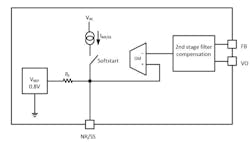Members can download this article in PDF format.
Noise, arising from thermal and other effects, is an inherent characteristic of every operating electronic component, circuit board, and system. Though completely eliminating noise isn’t possible, it can be minimized to ensure that systems ranging from medical equipment to radar RF transceivers operate properly—even in the presence of external conditions such as electromagnetic interference (EMI) and temperature fluctuations.
A good starting point for the design of sensitive equipment is to choose precision low-noise components to help minimize total system noise.
Noise in Electric Vehicles
Noise presents particular challenges for engineers designing electric vehicles (EVs). “In EVs, sensitive systems for safety or parking, which are vulnerable to excessive noise, sit in close proximity to the high-power components that produce the noise,” said Jeff Morroni, director of power-management research and development at Texas Instruments’ Kilby Labs. “This is what our low-noise and precision technologies are attempting to address.”
TI applies those technologies to a variety of precision low-noise products. Specifically for EV applications, TI is previewing the BQ79718-Q1 automotive 18S precise battery monitor, cell balancer, and integrated protector. The device is AEC-Q100-qualified and meets ISO 26262 functional-safety requirements up to Automotive Safety Integrity Level (ASIL) D.
The BQ79718-Q1 can measure down to the millivolt level, enabling accurate estimation of an EV’s remaining driving range. “We are talking in the ballpark of 10% to 15% improvement—enabled simply by the ability to measure the voltage more accurately,” said Morroni. “That directly translates to a customer value proposition in terms of the cost of batteries.”
Precision Low-Noise Buck Converters
The typical approach to powering noise-sensitive systems has been to employ a DC-DC converter, a linear low-dropout (LDO) regulator, and a ferrite bead (Fig. 1), an approach that works for currents up to approximately 2 A. As current increases, however, losses in the LDO regulator reduce efficiency and can cause thermal problems.
The LDO regulator in Figure 1, for example, dissipates 400 mW, or 16.7% of the 2.4 W delivered to the load. Reducing the voltage drop across the LDO regulator can help improve efficiency, but that approach exacerbates the noise problem that the LDO regulator was inserted to address.
An alternative is to eliminate the LDO regulator completely and employ a low-noise, low-ripple DC-DC converter (Fig. 2), such as a member of TI’s TPS62912 and TPS62913 family of low-noise buck converters.
These converters, as well as the company’s TPSM82912 and TPSM82913 modules, feature a noise-reduction/soft-start (NR/SS) pin. Connecting an external capacitor to this pin forms a low-pass resistor-capacitor filter in conjunction with the integrated Rf resistor (Fig. 3).
Like every DC-DC converter, these low-noise buck converters do generate output voltage ripple at their switching frequencies. A pi filter employing capacitors and a ferrite bead can reduce that ripple by approximately 30 dB.
To facilitate the design of such a filter, the TPS62912 and TPS62913 integrate ferrite-bead compensation and remote-sense feedback function. If you still have too much ripple, you can add an LDO regulator with a very low dropout voltage without incurring the penalty you would by adding one to a conventional DC-DC converter.
In addition to buck converters and EV battery monitors, TI has a variety of precision low-noise components, including the TPS7A94 1-A ultra-low-noise (0.46 µV rms) voltage regulator, which can source 1 A with only 150 mV of dropout. The low dropout and an integrated wide-bandwidth error amplifier allow for a very high power-supply rejection ratio (PSRR) of 110 dB at 1 kHz and 50 dB at 1 MHz under low operating headroom (500 mV) and high output current (750 mA).
TI also offers the REF70 ultra-high-precision voltage reference with low noise (0.23 ppm p-p), a low temperature drift coefficient (2 ppm/°C), and high accuracy (±0.025%). The device can serve in test and measurement, medical, and other applications that require a precise reference to be paired with precision, high-resolution data converters.
Precision Low-Noise Reference Designs
To help you get started using its precision low-noise products, TI has several reference designs for precision low-noise applications. Among them is the TIDA-010208, which provides accurate cell measurement and high-side MOSFET control for a 10S-16S battery pack (Fig. 4).
The design accurately monitors cell voltage, pack current, and cell and MOSFET temperature, and it protects an Li-ion LiFePO4 battery pack against cell overvoltage, cell undervoltage, overtemperature, charge and discharge overcurrent, and discharge short-circuit situations. It features low current consumption of 100 µA in standby mode and 10 µA in shipping mode, and targets e-bike and e-scooter applications.
The companion TIDA-010074 reference design targets 16S-17S battery packs for telecom battery-backup systems and e-motorcycles.
In addition, the TIDA-010249 reference design lets you explore the theory, design, and test of a synchronous, four-channel, wideband high-resolution integrated electronic piezoelectric (IEPE) sensor interface. Although the main target is vibration sensing, the design can also be applied to any application that requires 24-bit, 20-kHz data conversion, such as three-phase voltage and current monitoring. The design includes low-noise precision amplifiers and ultra-low-noise LDO regulators.
Finally, the TIDA-010230 multichannel, low-noise clocking reference design serves radar and electronic-warfare (EW) RF transceiver applications that require very low-noise clocking and precise channel-to-channel skew adjustment. The design includes low-noise and low-ripple DC-DC converters that approach the noise performance of LDO regulators, yet with improved efficiency.
Conclusion
Minimizing noise is critical in applications ranging from preventing anomalies in medical imaging to accurate estimation of remaining driving range in EVs. TI offers a variety of precision low-noise products that you can design into such applications, and it offers reference designs that can help you get started quickly.




